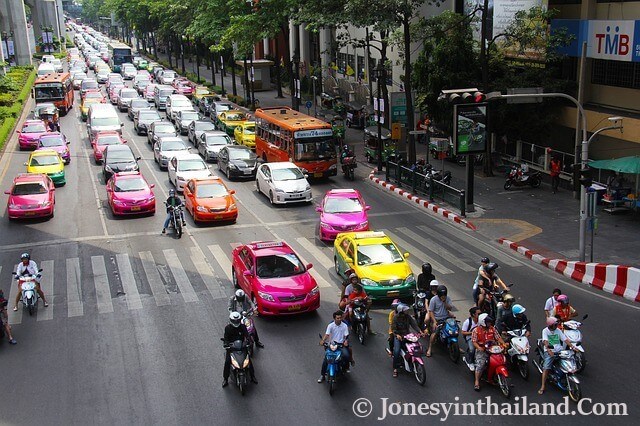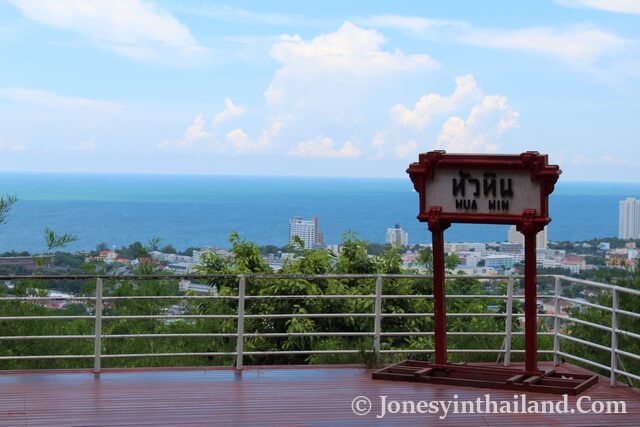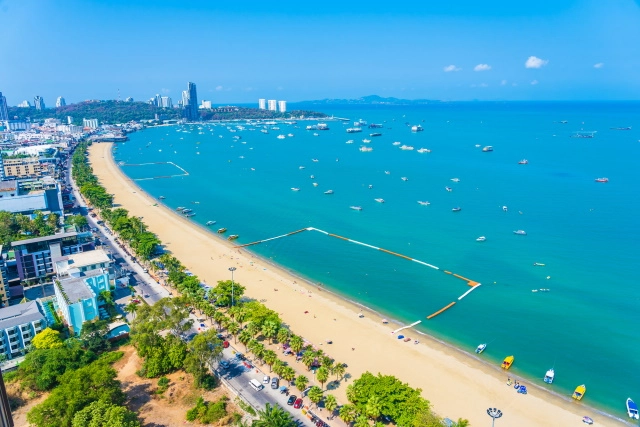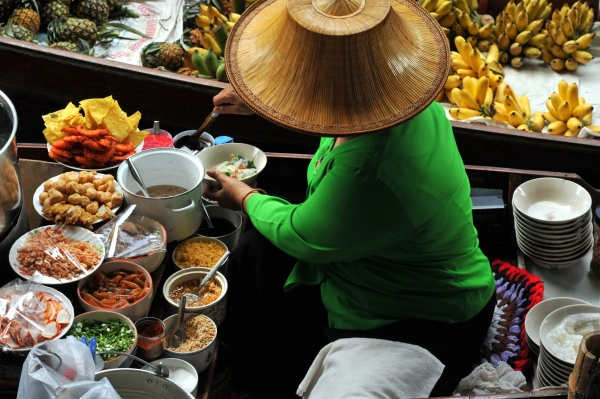The Thai Wai— a Brief Guide on How, When and Why
Greetings in Thailand are usually accompanied by the gesture known as a ‘wai’ (pronounced ‘why’). This is the placing together of both palms, with fingertips held at varying levels according to the person in front of you (which will be explained in more detail as this is the complicated bit).
Understanding how the wai greeting works is actually a great way to see how the culture operates in Thailand beyond its simple allure as a top holiday destination. Once you’ve tried it a few times you might realise it can also be a confusing, if not amusing way to see the local perception of how you fit into the general scheme of things.
If you do take the time to consider the wai until you think you get it, or at least feel comfortable with a basic version of it, you might then find it rather interesting to watch Thais greet and interact with each other. You may observe the great degrees of subtlety that can often find their way into this respectful and diverse gesture.
When and Why People Wai
Aside from its function as a form of greeting in formal and semi-formal situations (instead of the traditional Western handshake), the wai also serves many other purposes.
A wai can be a way of saying hello or goodbye, showing respect, appreciation, and even remorse. You will notice Thais also wai to temples, monuments, pictures, and spirit houses, among other things they consider worthy of high respect.
Different Types of Wai
A wai is often more than just a greeting though, as it indicates the level of respect for another person. The acknowledgement of seniority is one of the main determiners here, whether related simply to age or some other social nuance is involved.
In some ways the wai is comparable to a bow in Japanese culture, where the depth of the bow denotes level of respect and again this can often be very subtle. Thai culture dictates that a person should bow their head slightly with their palms pressed together to indicate respect, and it can also be very subtle in terms of both the depth of the bow and the height of the hands.
As a rule of thumb, the position of the hands is the main indicator of the level of respect being offered. The different types of wai are used for different situations, and Thai people are raised to inherently know the correct form to use.
Of course, things are changing and younger generations of Thais are becoming more globalised in their approach to life—especially with each other.
So while this form of greeting is still normal practice for the majority of Thais, the younger generation are becoming less and less rigid in their adherence to a culture that has always placed emphasis on seniority. Formal and semi-formal situations in the country still rigidly require such displays of manners though.
A Few Nuances to Consider
A senior person may politely wai in return to a person who is younger or subordinate to them—or they may not. If they do return the gesture it is usually with the hands at chest level. You might notice no fingertips are touching the face, and there will be only a slight bowing of the head, more like a nod.
Young children have to wai to pretty much everyone (without any return gesture) and they are also supposed to bend their knees when they make the gesture, whereas adults do not.
The Thai Ministry of Culture has apparently settled on 3 levels of wai: One for Buddhism, monks, and royalty; one for parents, older people, and other social superiors, and the last one is the standard, peer-to-peer gesture. The general rule of thumb is that hands will be held higher and the head bowed lower the more respect is being shown.
Let’s just have a slightly closer look at the three levels and their variations.
1. The ‘Standard’ or Peer-to-Peer Wai
This is used in general with people who you meet in a social situation. The head nods just slightly as the hands move up and the thumbs briefly touch the chin. Due to the setting this is a swift gesture rather than a drawn-out one—which is reserved for effect in ceremonies etc.

This kind of wai is also your ‘safest bet’ as a foreigner if you do insist on wai-ing—and is the most versatile. Your fingertips should go below your chin, briefly touching, with your palms touching together and your elbows tucked in. This is also a wai for anyone whose status you don’t yet know. Complex stuff, eh.
2. The More Respectful Wai
To show slightly more respect, the fingertips should climb to the tip of your nose or even to the level of the eyebrows for full effect with the thumbs on the tip of the nose.
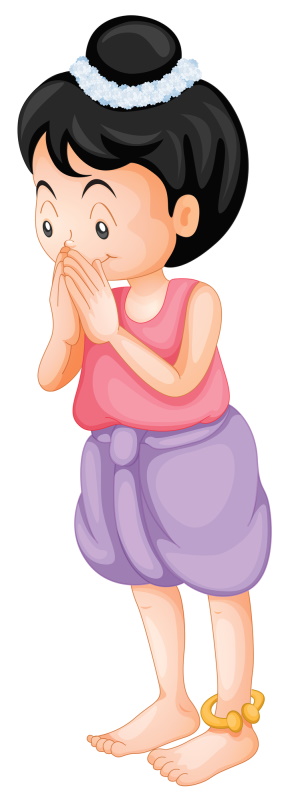
This wai is used when greeting older people or those you deem to have a higher standing in some way such as parents and teachers. From the starting position, as the head dips forward slightly the hands come up and again, although this is usually a fairly swift movement, it is often done more slowly than the first in order to give the gesture greater meaning and gravitas.
3. The Highest Wai
This wai is reserved as a sign of reverence and is used for monks and royalty. In this case, the head nod turns into a more obvious bow, this time with the hands sliding up so that the thumbs touch the eyebrows, or even the hairline. When it comes to a ‘royalty’ wai, male Thais will bow and females will curtsey whilst slowly making this gesture.
There is even a wai not included in the Ministry of Culture’s 3 recommendations. This gesture is reserved for some Buddha images and high-ranking monks, as well as the royal family. It involves prostration, and is only used for religious or royal contexts. You will see this wai in effect throughout any televised public ceremonies, particularly ones involving members of the royal family.
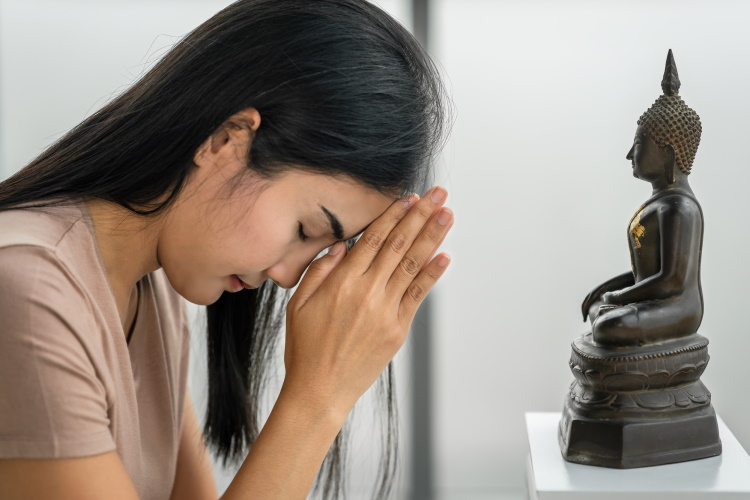
When NOT to Wai
So we have already mentioned that Thai custom does not include a wai to children—even if you are tempted to do so after being cutely greeted by them. A quick nod of the head in acknowledgment will suffice, as will a warm smile. You will notice a lot of Thais may simply raise their hands to the starting position of the gesture and then drop them without moving the fingers up towards the face.
Although many westerners are uncomfortable with what they feel to be a somewhat cold show of disrespect by not returning a wai, it is important to know that things are as they are in Thailand and no attempt to diversify or alter that will have any effect here—especially from a non-Thai.
Whether you like it or not, social standing is worn very much on the sleeve in Thai society, which for the most part you are not considered any part of. Fact.
You should never wai when dealing with anyone in the service industry, for instance. This includes staff in restaurants, bars, spas, cinemas, etc., as well as security guards, taxi drivers, and anyone who is in a kind of subordinate position where they are providing a service. This stands regardless of age, which can obviously cause a few conflicts here and there from time to time (and does!).
Inappropriate use of a wai can often make locals feel a little bemused. Foreigners for some reason tend to look or seem a little strange to many non-Thais without too much experience of dealing with them—especially during some ham-fisted attempt at being more Thai—which brings us to our next point.
Foreigners and the Wai
As a foreign visitor (which will stick even after 20 years as an expat) you will not be expected or considered to understand any of the nuances of the culture—so don’t sweat it.
One important thing to know about wai-ing is that it is always the social inferior (whether by age, rank, or standing) who initiates it. This means that as a (paying) visitor it is unlikely that you will meet any situation where you would be expected to wai first.
It may sound like a licence for bad behaviour (it’s not), but as a foreigner you’re largely excluded from Thailand’s most nuanced courtesies. Due to the subtle levels and nuances used in the gesture, it’s a safe bet to say you’re probably not going to get it right.
You will find some Thai people have different ideas about foreigners and wai-ing—but that has to be more their issue rather than yours. Some people will tell you it is not necessary for foreigners to wai, and this is the majority.
However, you may encounter some folk who will tell you this is Thailand and if you don’t do it then it means you don’t respect them. Certainly, respect seems to be a recurring major issue in this country, for sure. This way of thinking exists among the minority of Thais in the city, but it could be somewhat different when venturing to largely rural areas etc., where customs have changed little in the last 50 years or so.
If you are uncertain what to do when someone wais to you, return the gesture with a kind smile and an acknowledging nod, and this should suffice for the majority of people visiting the country.
Just being seen to try and show respect will often be appreciated even if you don’t always get it quite right. Many Thais really consider their culture unique and hence inaccessible by anyone raised outside of it. Your status as a non-Thai gives you plenty of room for error without too much judgement, but try not to overdo it.
Other Subtle Cultural Touches Worth Knowing
In both a formal and informal situation, Thai people greet each other with the word ‘sawadee’ followed by ‘kah’ (for females) and ‘kraap’ (soft r) for males. It is also common to refer to someone of a perceived higher status by the title ‘Khun’ (Mr/Ms) followed by their first name. People of the same age or who are close friends won’t use the Khun title, and when it comes to ‘nicknames’ (most Thai people have a short, one or two-syllable nickname) they are generally only used when invited to do so.
You may notice other etiquette such as when making introductions. Thais tend to introduce a man to a woman (rather than vice versa) and a younger person to an older person. You may even find some people offering a handshake as an acceptable greeting—usually in business—yet a male may only shake a female’s hand if she extends it to him first.
The Bottom Line
The Thai wai is a graceful and respectful gesture that can be used in a wide variety of different contexts. Once you have spent a little time investigating the matter you may find yourself paying much closer attention to the way natives use the wai, and realise there is a little more to it than meets the eye. If you are a first-time or even a returning visitor to the country, there really is no need to sweat this one too much. You can decide for yourself whether or not it is for you going by how you feel and some of the reactions you get. Nevertheless, the wai gesture is an integral part of Thai culture and identity, and it is worth knowing about if you have any interest in the country and its people.

Mark Philip is a writer and lifestyle enthusiast from the Midlands in the U.K. With a background in martial arts and fitness, Mark upped sticks and headed out to Bangkok to delve a bit deeper into the art of Thai Boxing way back in the 2000s, starting to write initially to fund his daily training and escape the rigours of ESL teaching. Since then Mark has authored e-books, articles, and blogs across a wide range of topics for commercial, educational, factual, health & fitness, lifestyle, wellness, and leisure-based purposes.

